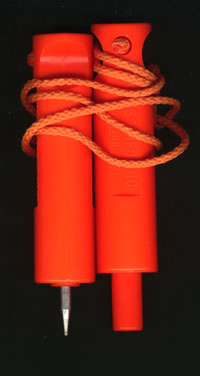The late-January sun warms your face as
you skirt a cedar thicket along the shore of a small, eastern
Upper Peninsula lake. Confident there's plenty of solid ice,
you strike out for the opposite shore. An occasional snowmobile
track crisscrosses the lake. A solitary green cedar branch
marks an old ice-fishing hole. The sharp rapport of a tree
cracking in the distance reminds you the mercury hasn't risen
above zero in almost two weeks.
Moments later, you're gasping for air,
struggling to stay afloat in the icy water. For an instant,
you've lost your sight. Then you realize your eyelashes are
frozen together. One of your skis bobs to the surface next
to you. Your mind races. "How could I have broken through
the ice in January?" Then it dawns on you. It's a spring-fed
trout lake. Acting like a marina bubbler system, the springs
have prevented the ice from freezing in certain locations.
To make matters worse, the open holes have drifted over with
crusty snow.
Your instinct to survive takes over. You
frantically claw at the ice, struggling to pull yourself out.
More than once you're almost out, only to loose your grip
on the slippery ice and slide back into the numbing water.
Before long, your fingers are too numb to even claw at the
ice. You search your pockets for something sharp, but your
hands don't work. They're frozen. "If only I had something
to 'dig' into the ice," you think. "Something to
pull myself out with." Before long, only a ski remains
afloat.
Could this happen to you? If you don't
carry ice picks it could. Ice rescue picks are nothing more
than a couple of sharp objects used to get a grip on the ice.
Ideally, they'll float and be tethered together by a lanyard
to prevent accidental loss.
Trappers often carried a couple of large
log-cabin spikes in their pockets. Today, some outdoor enthusiasts
still carry nails while others carry a pair of screwdrivers
or awls on a lanyard. If you're handy with a few basic tools,
you can even make your own ice picks with two pieces of doweling
and a couple of large nails. For my first set of ice picks,
I inserted nails into a couple of extra-large wooden file
handles.
Ice picks are commercially manufactured
too. Check with your local sporting goods store or ice fishing
shop for a pair. For the last few years, I've carried professional-grade
rescue picks marketed under the name of Angel-Guard (formerly
Hammes Pick-Of-Life). Popular with rescue squads across the
country, these ice picks consist of a pair of four-inch-long,
one-inch-diameter, bright orange plastic cylinders tethered
together by a long lanyard. A sharp spike protrudes from each
cylinder and is protected by a retractable pocket guard.
Angel-Guard ice picks are available for
$20 plus shipping from Rock-n-Rescue, PO Box 213, Valencia,
Pennsylvania, 16059-0213, 1-800-346-7673 (order item no. POL-1).
Ice picks should be carried in a location
where they'll be readily accessible when you're submerged.
I like to carry mine in a pouch attached high on the shoulder
strap of my backpack. They can also be carried in an accessible
pocket or hung around your neck by the lanyard. Others like
to thread the lanyard through the sleeves of their jacket
so the picks dangle at the ready near each hand. How ever
you carry them, make sure there's no way you'll accidentally
impale yourself on them if you happen to fall.
To use a set of ice picks, simply grasp
one in each hand and plunge the spiked ends into the ice in
a hand-over-hand fashion as you pull yourself onto the ice.
Make sure you exit the hole in the same direction from which
you entered, as this is the only known path of supporting
ice.
Once you're out of the water and on the
ice, don't stand up. Instead, keep your weight dispersed by
rolling away from the hole, in the direction from which you
originally came. Once safely on shore, re-warm yourself with
a roaring fire and change into some dry clothing.
Whether you invest some time or money in
a pair of ice picks, it may well be the best investment you'll
ever make. One thing I know for sure, you'll never catch me
skiing or snowshoeing across a beaver pond without a pair
of ice picks handy.
|


